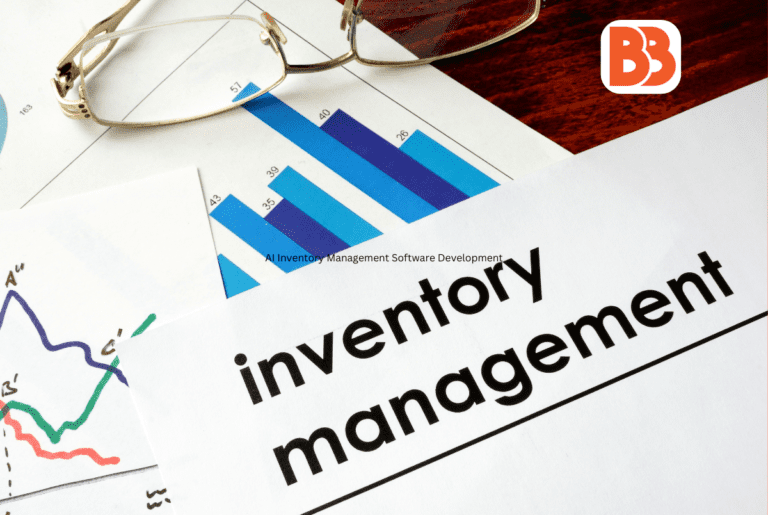Inventory management is essential for any business dealing with material goods. It involves tracking, controlling, and optimizing the flow of products from suppliers to customers. However, AI inventory management software is a software solution that uses artificial intelligence techniques to automate and optimize various inventory management tasks. This article will explore the benefits, workings, development, and best practices of AI inventory management software development.
What are the challenges faced by AI Inventory Management Software Development?


However, traditional inventory management methods often face challenges such as:
- Inaccurate demand forecasting that leads to overstocking or stockouts
- Manual and error-prone procedures that destroy time and resources
- Lack of real-time visibility and analytics that hinder decision-making
- High inventory carrying costs and operational inefficiencies
Ways to Overcome Challenges
To overcome these challenges, businesses must adopt a smarter and more efficient way of managing their inventories. It is where AI inventory management software development comes in.


It is a software solution that uses artificial intelligence (AI) techniques such as machine learning, natural language processing, computer vision, and robotics to automate and optimize inventory management tasks.
Benefits of AI inventory management software development
Some of the benefits of AI inventory management software development are:
- Improved demand forecasting that reduces inventory waste and improves customer satisfaction
- Automated order management and replenishment that saves time and labor costs
- Real-time inventory tracking and optimization that maximizes inventory turnover and profitability
- Advanced reporting and analytics that provide insights and recommendations for inventory improvement
- Enhanced inventory security and compliance that prevent theft and fraud
How Does AI Inventory Management Software Work?
Collecting and analyzing Data:
It collects and analyzes large amounts of data from various sources, such as historical sales, customer behavior, market trends, weather, and social media.
Machine learning algorithms:
It then uses machine learning algorithms to identify patterns and trends in the data and generate accurate and reliable demand forecasts for each product and location.
Placing orders with the suppliers:
Based on the demand forecasts, the software can automatically place orders with suppliers, adjust inventory levels, and allocate inventory to optimal locations. It can also monitor the inventory status in real-time and alert users of potential issues, such as low stock, high demand, or delayed shipments.


Natural language processing:
Additionally, the software can use natural language processing to understand and respond to voice commands, computer vision to scan and recognize barcodes and QR codes, and robotics to automate warehousing and picking operations. These features can enhance the user experience and efficiency of the inventory management process.
How to Develop AI Inventory Management Software?
It requires technical skills, domain knowledge, and business acumen. The following are some of the steps involved in it:
Define the project scope and requirements:
The first step is understanding the project’s business goals, challenges, and expectations. It involves identifying the target users, the key features, the data sources, and the software’s performance metric
Choose the right development platform and tools:
The next step is to select the project’s best development platform and tools. It depends on factors such as the budget, the timeline, the scalability, and the security of the software. Some of the popular platforms and tools for its development are Microsoft Azure, Google Cloud, Amazon Web Services, TensorFlow, PyTorch, and OpenCV.
Design and develop the software:
The third step is to design and develop the software using the chosen platform and tools. It involves creating the user interface, the database, the backend, and the AI models for the software. The software should follow the best software engineering practices, such as modularization, documentation, testing, and debugging.
Deploy and maintain the software:
The final step is to deploy and maintain the software on cloud or on-premise servers. This involves ensuring the software is compatible with existing systems, the data is secure and updated, and the software runs smoothly and efficiently. The software should also be monitored and improved regularly based on user feedback and changing business needs.
Frequently asked questions
Here are some of the frequently asked questions:
1: How much does it cost to develop AI inventory management software?
A: The cost of its developing depends on various factors, such as the complexity, functionality, platform, tools, and development team of the software. According to some estimates, the average cost ranges from $50,000 to $500,000.
2: How long does it take to develop AI inventory management software?
A: Its duration varies depending on the above mentioned factors. Generally, it can take anywhere from 3 months to 12 months.
3: What are the best practices for developing AI inventory management software?
A: For its development, one should conduct market research and user analysis, choose the right platform and tools, follow the agile methodology, apply the latest AI techniques, test and validate the software, and seek feedback and suggestions. It requires market research, user analysis, platform and tool selection, agile methodology, AI techniques, testing, validation, and feedback.
Conclusion
In conclusion, AI inventory management software development is a smart solution for modern businesses that want to optimize their inventory processes and improve customer satisfaction and profitability. By using AI techniques such as machine learning, natural language processing, computer vision, and robotics, it can automate and enhance various inventory management tasks, such as demand forecasting, order management, inventory tracking, and inventory optimization. However, developing it is not easy. It requires many technical skills, domain knowledge, and business acumen.
Read more :
